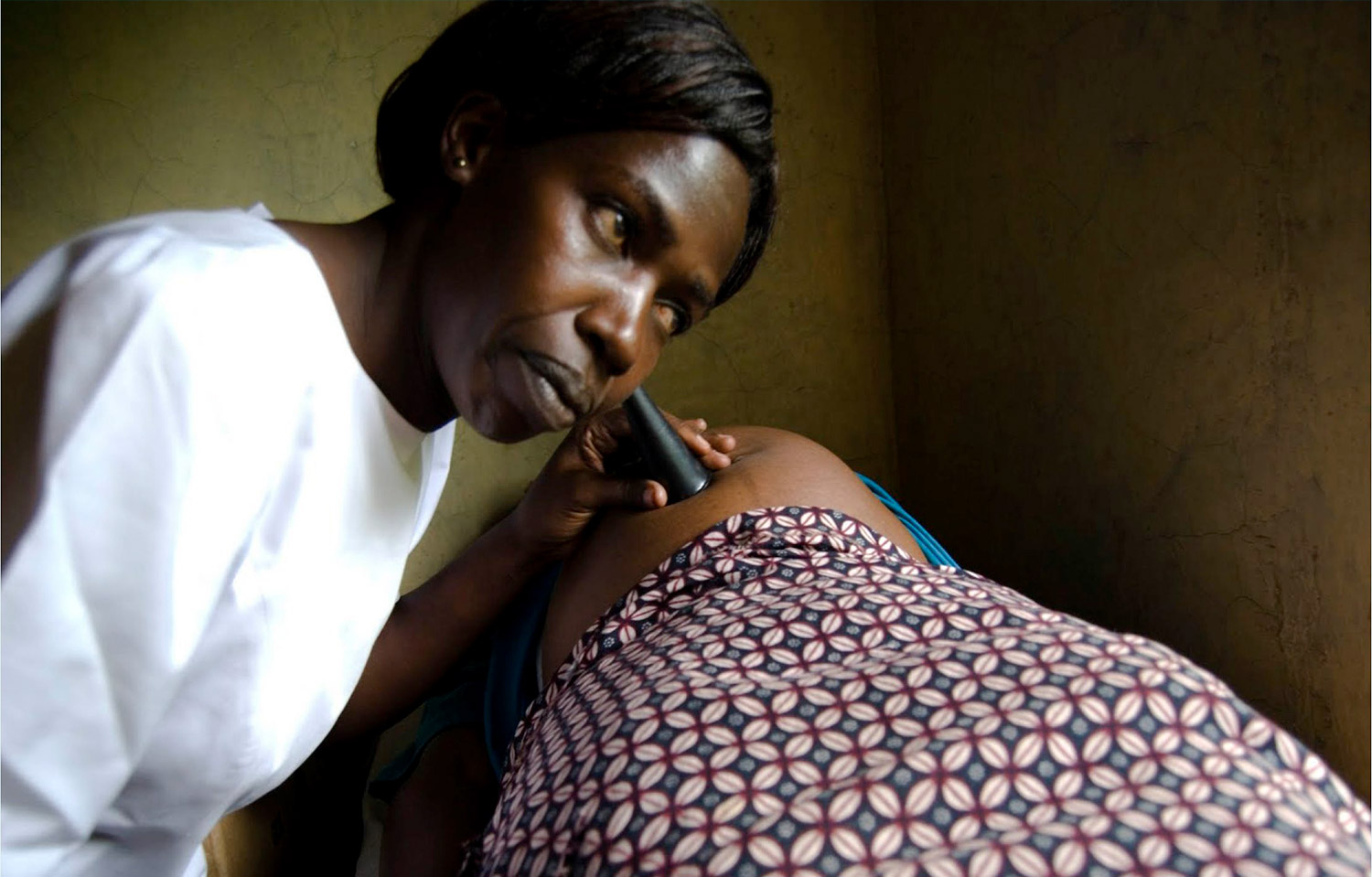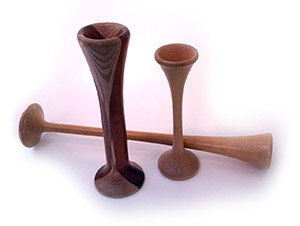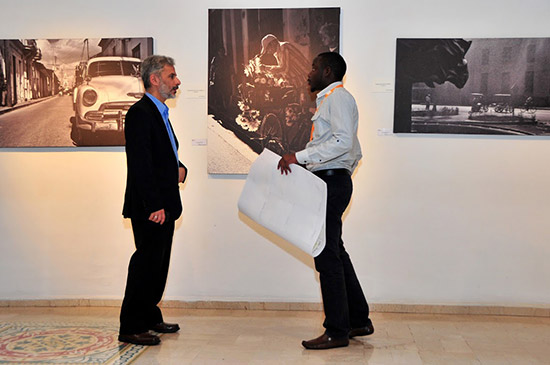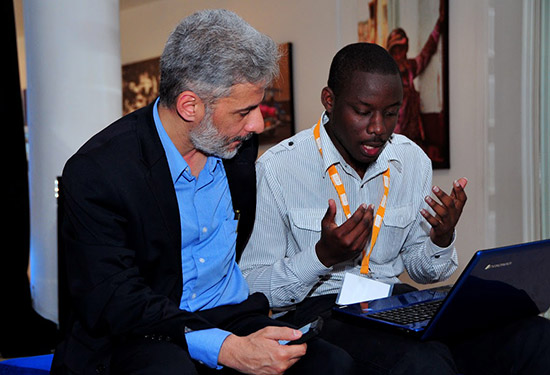
By:
- Scott LaFee
Published Date
By:
- Scott LaFee
Share This:
Listening for Life
Professor mentors entrepreneur from Uganda with invention to improve prenatal care in developing countries

Pinard horns are still commonly used in parts of the world where modern healthcare technologies are scarce or limited.
In a surprisingly large chunk of the world, prenatal care looks – or more accurately, sounds – like this: A small, conical wooden tube used to listen to heartbeat of an unborn child.
The Pinard horn or fetoscope was invented by Adolph Pinard in 1895 after the French obstetrician noticed that sound was greatly amplified when it passed through a tube pressed against a pregnant woman’s belly.

A collection of traditional Pinard horns or fetoscopes.
Modern medicine long ago progressed to stethoscopes and technologies such as Doppler monitors, which employ sonic waves to detect fetal heartbeats, but Pinard horns continue to be the tool of choice, if not necessity, in developing countries where healthcare is limited. And where, according to international health authorities, most of the 3 million newborn deaths and 2.5 million stillbirths occur each year.
These facts are well known to Dr. Wael Al-Delaimy. As professor of epidemiology and chief of the Division of Global Health in the Department of Family Medicine and Public Health at the UC San Diego School of Medicine, Al-Delaimy has devoted much of his career to addressing healthcare issues and crises around the world.
“They’re part of my perspective, my interest in improving health irrespective of borders or background,” he said.

Dr. Wael Al-Delaimy, a professor of epidemiology and chief of the Division of Global Health, collaborated with Edmund Ainebyona, a Ugandan entrepreneur, at the Global Innovation in Science and Technology summit last year in Morocco.
Late last year, Al-Delaimy was invited by the American Association for the Advancement of Science and the U.S. Department of State to participate in an unusual competition called the GIST Initiative, short for Global Innovation in Science and Technology. Thirty would-be entrepreneurs from developing countries would gather in Morocco to present their ideas or devices related to health, agriculture, technology or energy to a panel of international judges. The winners would receive modest cash prizes but, maybe more importantly, they might garner the attention of investors who could provide the funding necessary to turn their aspirations into reality.
“It was a novel idea. Anybody with any idea that was innovative could submit a 5-minute video describing either an idea or a start-up prototype,” Al-Delaimy said. “There were hundreds of applications and these were winnowed down to 67 semi-finalists and then, after another round of filtering, to 30 finalists who were invited to give presentations during the four-day Global Entrepreneurship Summit in Marrakech in November.”
The catch – besides having a good idea or product – was that most of the competitors had little or no knowledge about how to make a good sales pitch or turn an idea into a marketable product. Many had never been outside of their country before. Some had never been on a plane.
Besides serving as a judge, Al-Delaimy and his 15 fellow experts (covering the different sectors of the competition, all volunteers) were asked to spend the first two days of the summit mentoring contestants.
Enter Edmund Ainebyona, a young computer scientist from Uganda representing a small company with an idea about how to make Pinard horns more effective, and thus improve the health and welfare of women and children whose lives might depend upon them.
“Edmund was very shy and soft-spoken. He had a great idea, but it needed much more work to be highly competitive,” said Al-Delaimy.
The idea was fairly straightforward: Ainebyona and his partners at WinSenga had tinkered with the basic Pinard horn, inserting a tiny microphone that connected to a Windows-based cell phone (the cheapest they could find) and an app specifically created to amplify and record fetal heartbeats.

Dr. Wael Al-Delaimy mentored Ainebyona on ways to improve development, marketing and public outreach for a smartphone version of the Pinard horn or fetoscope, a type of stethoscope invented in the 19th century to listen to fetal heartbeats.
“It was a really smart, noble idea that could make a huge difference,” said Al-Delaimy. “Most deaths are due to a lack of prenatal care. I learned that Edmund’s mother had died giving birth to him, so that was probably part of his motivation and made me even more committed to help him and his endeavor.
“Midwives could use these specially-equipped horns to see more patients, but I convinced him that the real goal should be for mothers to eventually use them. If they didn’t feel their fetus kicking, with some basic training they could listen and see if they needed to get further medical help.”
Al-Delaimy spent hours with Ainebyona preparing and honing his 5-minute, 7-slide presentation to an audience of judges and participants. (Al-Delaimy recused himself as one of the judges for Ainebyona’s presentation.) Ainebyona took third place in the start-up division, garnering a prize and some much needed publicity.
“That’s the most important thing,” said Al-Delaimy. “Venture capitalists will be able to see his now-publicized work and because he’s been through this lengthy evaluation and mentoring process, the idea of the device filtered and screened, they’ll know that it must have merit and be worth a look.”
Al-Delaimy hasn’t heard from Ainebyona since Morocco, but he hopes to reconnect.
“I promised him that I would always be available to mentor him. I really believe this device can save thousands of lives and I feel privileged to have been a part of the process. At the end of the day, we must be passionate about helping our fellow humans. It is our ethical obligation, whether they are here in San Diego or across the world in Uganda.”
Share This:
You May Also Like
Stay in the Know
Keep up with all the latest from UC San Diego. Subscribe to the newsletter today.


